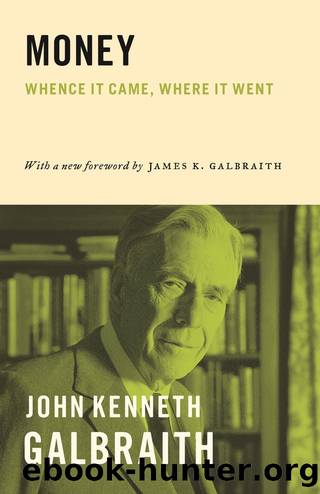Money: Whence It Came, Where It Went by Galbraith John Kenneth

Author:Galbraith, John Kenneth [Galbraith, John Kenneth]
Language: eng
Format: epub
Tags: History, Politics, Philosophy, Business, Reference, Sociology
ISBN: 9780691171661
Amazon: 0691171661
Goodreads: 32911711
Publisher: Princeton University Press
Published: 1975-01-01T08:00:00+00:00
1 Price data from Bulletin de la Statistique Générale de la France, Paris, Librairie Félix Alcan, Vol. XV, No. II (October 1925), p. 14, and Vol. XVII, No. II (JanuaryâMarch 1928), p. 132.
2 Martin Wolfe, The French Franc Between the Wars, 1919â1939 (New York: Columbia University Press, 1951), p. 213.
3 W. F. Ogburn and W. Jaffe, The Economic Development of Post-War France (New York: Columbia University Press, 1929). Cited in T. Kemp, The French Economy 1913â1939 (London: Longman Group, 1972), p. 67. This last is a most useful and succinct study.
4 Alfred Sauvy, Histoire Economique de la France entre les Deux Guerres, Vol. I, 1918â31 (Paris: Fayard, 1965). Cited in Charles P. Kindleberger, The World in Depression 1929â1939 (Berkeley and Los Angeles: University of California Press, 1973), p, 48. The latter is the best book in English on the Great Depression, and one to which I am much indebted.
5 Frank D. Graham, Exchange, Prices and Production in Hyper-Inflation: Germany 1920â1923 (Princeton: Princeton University Press, 1930), p. 7. This study, by an admired friend and onetime Princeton colleague, is a basic source on the German inflation. It is a subject on which the literature is vast.
6 John Maynard Keynes, The Collected Writings of John Maynard Keynes, Vol. II: The Economic Consequences of the Peace (London: Macmillan & Co., 1971).
7 R. F. Harrod, The Life of John Maynard Keynes (London: Macmillan & Co., 1963), p. 296. According to the legend current in Cambridge (England) during my time there, Keynes was bailed out by his father, John Neville Keynes, also of the University. This, according to Harrod, was not the case; Keynes, he says, did reveal his plight to his parents who, not surprisingly, counseled caution.
8 Price levels are from Graham, pp. 156â159.
9 Norman Angell, The Story of Money (New York: Frederick A. Stokes Co., 1929), pp. 334â335.
10 Angell, pp. 335â336.
11 The New York Times, October 30, 1923.
12 The New York Times, December 7, 1923.
13 Graham, p. 63.
14 A recent writer, Richard M. Watt, suggests that, over the reparations period, Germany paid 36 billion marks, borrowed 33 billion from abroad. Most of these loans went unpaid. In The Kings Depart (New York: Simon and Schuster, 1968), p. 504.
15 Nineteen twenty-three trade union figures are from Graham, p. 317. Others are from Angus Maddison, âEconomic Growth in Western Europe 1870â1957,â in Warren C. Scoville and J. Clayburn La Force, The Economic Development of Western Europe from 1914 to the Present (Lexington, Massachusetts: D. C. Heath & Co., 1970), p. 56, and are adjusted to include all wage earners.
16 Unemployment figures are from Maddison, p. 56. Guillebaud, who excludes some nonindustrial categories, puts unemployment in 1931 at around one-quarter of the labor force and in 1932 at one-third. C. W. Guillebaud, The Economic Recovery of Germany (London: Macmillan & Co., 1939). p. 31.
17 Later in the â30s, Brüning joined the Harvard faculty as Professor of Government. At a welcoming seminar one evening I asked him if his Draconian measures at a time of general deflation had not advanced the cause of Adolf Hitler.
Download
This site does not store any files on its server. We only index and link to content provided by other sites. Please contact the content providers to delete copyright contents if any and email us, we'll remove relevant links or contents immediately.
International Integration of the Brazilian Economy by Elias C. Grivoyannis(91111)
The Radium Girls by Kate Moore(11921)
Turbulence by E. J. Noyes(7936)
Nudge - Improving Decisions about Health, Wealth, and Happiness by Thaler Sunstein(7615)
The Black Swan by Nassim Nicholas Taleb(7010)
Rich Dad Poor Dad by Robert T. Kiyosaki(6401)
Pioneering Portfolio Management by David F. Swensen(6226)
Man-made Catastrophes and Risk Information Concealment by Dmitry Chernov & Didier Sornette(5921)
Zero to One by Peter Thiel(5686)
Secrecy World by Jake Bernstein(4646)
Millionaire: The Philanderer, Gambler, and Duelist Who Invented Modern Finance by Janet Gleeson(4376)
The Age of Surveillance Capitalism by Shoshana Zuboff(4210)
Skin in the Game by Nassim Nicholas Taleb(4162)
Bullshit Jobs by David Graeber(4094)
The Money Culture by Michael Lewis(4076)
Skin in the Game: Hidden Asymmetries in Daily Life by Nassim Nicholas Taleb(3929)
The Dhandho Investor by Mohnish Pabrai(3699)
The Wisdom of Finance by Mihir Desai(3654)
Blockchain Basics by Daniel Drescher(3507)
